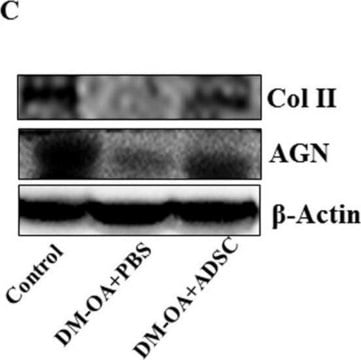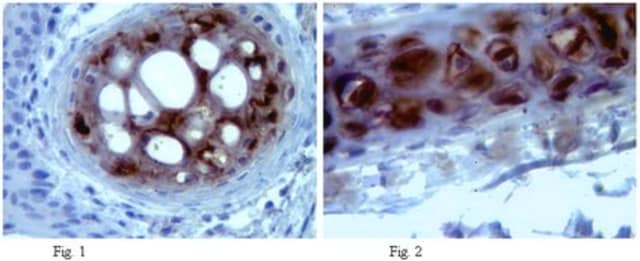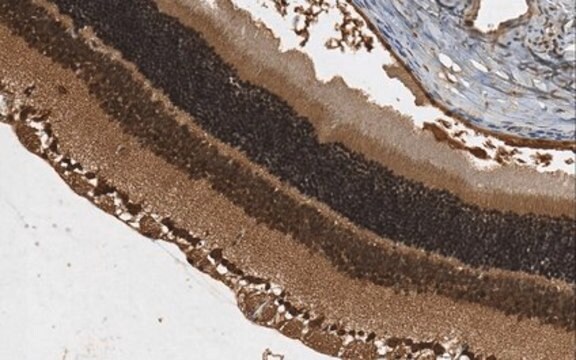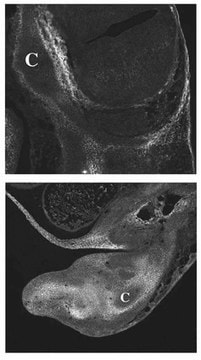AB1031
Anti-Aggrecan Antibody
CHEMICON®, rabbit polyclonal
Synonym(e):
Cartilage-specific proteoglycan core protein, Cartilage-specific proteoglycan core protein, aggrecan 1 (chondroitin sulfate proteoglycan 1, large aggregating proteoglycan, antigen identified by monoclonal antibody A0122), aggrecan proteoglycan, aggrecan
About This Item
Empfohlene Produkte
product name
Anti-Aggrecan Antibody, Chemicon®, from rabbit
Biologische Quelle
rabbit
Qualitätsniveau
Antikörperform
affinity isolated antibody
Antikörper-Produkttyp
primary antibodies
Klon
polyclonal
Aufgereinigt durch
affinity chromatography
Speziesreaktivität
mouse
Hersteller/Markenname
Chemicon®
Methode(n)
immunofluorescence: suitable
immunohistochemistry: suitable (paraffin)
immunoprecipitation (IP): suitable
western blot: suitable
NCBI-Hinterlegungsnummer
UniProt-Hinterlegungsnummer
Versandbedingung
dry ice
Posttranslationale Modifikation Target
unmodified
Angaben zum Gen
human ... ACAN(176)
Allgemeine Beschreibung
Spezifität
Immunogen
Anwendung
Zellstruktur
ECM-Proteine
A previous lot of this antibody was used at 10 μg/mL. See note under Protocol regarding triton X-100 treatments.
Immunoprecipitation:
A previous lot of this antibody was used at 5 μg/ 500 μL of cell membrane extract in PBS with inhibitors and >0.5% triton X-100.
Qualität
Western Blot Analysis:
1:500 dilution of this lot detected AGGRECAN on 10 μg of Mouse Brain lysates.
Physikalische Form
Note: Aggrecan is present in articular cartilage, brain, heart, and other tissues.
Lagerung und Haltbarkeit
Handling Recommendations: Upon first thaw, and prior to removing the cap, centrifuge the vial and gently mix the solution. Aliquot into microcentrifuge tubes and store at -20°C. Avoid repeated freeze/thaw cycles, which may damage IgG and affect product performance.
Hinweis zur Analyse
Cartilage, neural tube, and brain tissue.
Sonstige Hinweise
Rechtliche Hinweise
Haftungsausschluss
Sie haben nicht das passende Produkt gefunden?
Probieren Sie unser Produkt-Auswahlhilfe. aus.
Lagerklassenschlüssel
12 - Non Combustible Liquids
WGK
WGK 2
Flammpunkt (°F)
Not applicable
Flammpunkt (°C)
Not applicable
Analysenzertifikate (COA)
Suchen Sie nach Analysenzertifikate (COA), indem Sie die Lot-/Chargennummer des Produkts eingeben. Lot- und Chargennummern sind auf dem Produktetikett hinter den Wörtern ‘Lot’ oder ‘Batch’ (Lot oder Charge) zu finden.
Besitzen Sie dieses Produkt bereits?
In der Dokumentenbibliothek finden Sie die Dokumentation zu den Produkten, die Sie kürzlich erworben haben.
Kunden haben sich ebenfalls angesehen
Unser Team von Wissenschaftlern verfügt über Erfahrung in allen Forschungsbereichen einschließlich Life Science, Materialwissenschaften, chemischer Synthese, Chromatographie, Analytik und vielen mehr..
Setzen Sie sich mit dem technischen Dienst in Verbindung.









